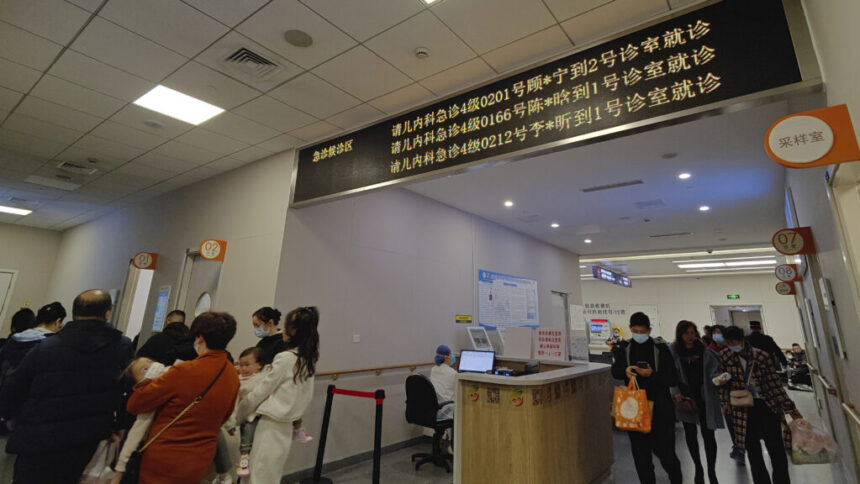The World Health Organization and Chinese health officials convened via a conference call on Thursday as the global health agency sought information about reports of increases in respiratory illnesses among children in China that have put disease watchers elsewhere on alert.
The Chinese explanation — one that the WHO appears to have accepted — is that while respiratory disease activity in parts of the country is at high levels among young children, the illnesses are caused by known pathogens.
A report of the meeting issued by the WHO said multiple viruses — influenza, respiratory syncytial virus or RSV, and adenoviruses — as well as mycoplasma pneumoniae, one of the bacterial causes of pneumonia, have been circulating in China for weeks, or in the case of mycoplasma pneumoniae, months. While the timing of the circulation is unusual in some cases, the illness being observed is not.
“Chinese authorities advised that there has been no detection of any unusual or novel pathogens or unusual clinical presentations … but only the aforementioned general increase in respiratory illnesses due to multiple known pathogens,” the WHO statement said. “They further stated that the rise in respiratory illness has not resulted in patient loads exceeding hospital capacities.”
The WHO statement concluded that with the arrival of winter weather, cases of these illnesses will likely continue to increase and could strain hospital resources. It noted that mycoplasma pneumoniae is easily treated with antibiotics.
Reports of high levels of respiratory illnesses among children in China appear to have sounded disquieting echoes of the start of the Covid-19 pandemic in some quarters. That disease, caused by the SARS-CoV-2 virus, began in China sometime in late 2019, hitting the greater world’s radar around New Year’s Day, 2020.
The WHO, which was pilloried at the start of the Covid pandemic due to a perception that it should have taken a harder line with less-than-forthcoming Chinese authorities, was quick to formally seek information from China, making the request under the auspices of the International Health Regulations. The IHR requires countries to alert the WHO of disease outbreaks that could threaten to spill across borders.
After the meeting Thursday, the WHO said it would continue to monitor the situation, and urged other countries not to impose travel restrictions on China.
But even before the meeting, a number of infectious diseases experts expressed the view that the answer to what was going on in China was a pattern that has been seen elsewhere in the aftermath of the Covid pandemic, which for a time suppressed transmission of seasonal respiratory bugs like flu and RSV.
As measures used to slow spread of Covid were jettisoned — mask wearing abandoned, schools reopened, and domestic and international travel resumed — diseases that had been circulating at very low levels in 2020 and 2021 started to rebound. At times, though, transmission of these bugs occurred outside their pre-Covid patterns, such as the surge of kids suffering from RSV that swamped pediatric hospitals in the early autumn of 2022.
“This does not have any hallmarks of a new and emerging pathogen challenge,” Michael Osterholm, director of the University of Minnesota’s Center for Infectious Diseases Research and Policy, told STAT earlier Thursday.
He and others said the relative absence of transmission of regular respiratory pathogens in the early years of the pandemic created a pool of young children with little or no immunity to these viruses. No surprise, then, that the return of the bugs would lead to high numbers of infections.
That phenomenon is especially true in China, which used draconian measures for years to stop the spread of Covid. The zero Covid policy, as it was called, was only abandoned in late 2022 when the highly transmissible Omicron variant of SARS-2 — and the Chinese public’s fatigue with the restrictions of the policy — made the approach untenable.
“Other countries, including the U.K., experienced big waves of respiratory infections and hospitalizations in kids during their first winter after pandemic restrictions had been lifted,” said Francois Balloux, director of the University College London’s Genetics Institute, in a statement released by the United Kingdom’s Science Media Center.
“Since China experienced a far longer and harsher lockdown than essentially any other country on earth, it was anticipated that those ‘lockdown exit’ waves could be substantial in China,” Balloux said.
Osterholm agreed. “There, immunologically, kids under age 4 are really quite naive to most of these viruses.”
Ben Cowling, chair of epidemiology at Hong Kong University’s School of Public Health, told STAT recently that in terms of getting back to pre-pandemic patterns of respiratory diseases transmission, Hong Kong and China are further behind the curve than North America and Europe. He noted that influenza activity in Hong Kong only resumed in the spring of 2023. While North America experienced no flu season during the winter of 2020-21, there was a mild flu season in 2021-22, followed by an active and abnormally early flu season in 2022-23.
Cowling said Hong Kong experienced a surge of flu cases last month, at a time when influenza transmission is not normally high. He was not alarmed by the level of respiratory activity in China. “There’s been a winter surge for more than a month already,” he said in an email. “Doesn’t seem to be anything panic-worthy.”
Other experts noted that the fact that the illnesses appear to be occurring mostly in children pointed away from the notion that a new pathogen might be circulating. (There have also been some cases reported among teachers.) Were there to be a new bug, both children and adults would lack immunity to it, leading to cases at all ages.
This article has been updated.









